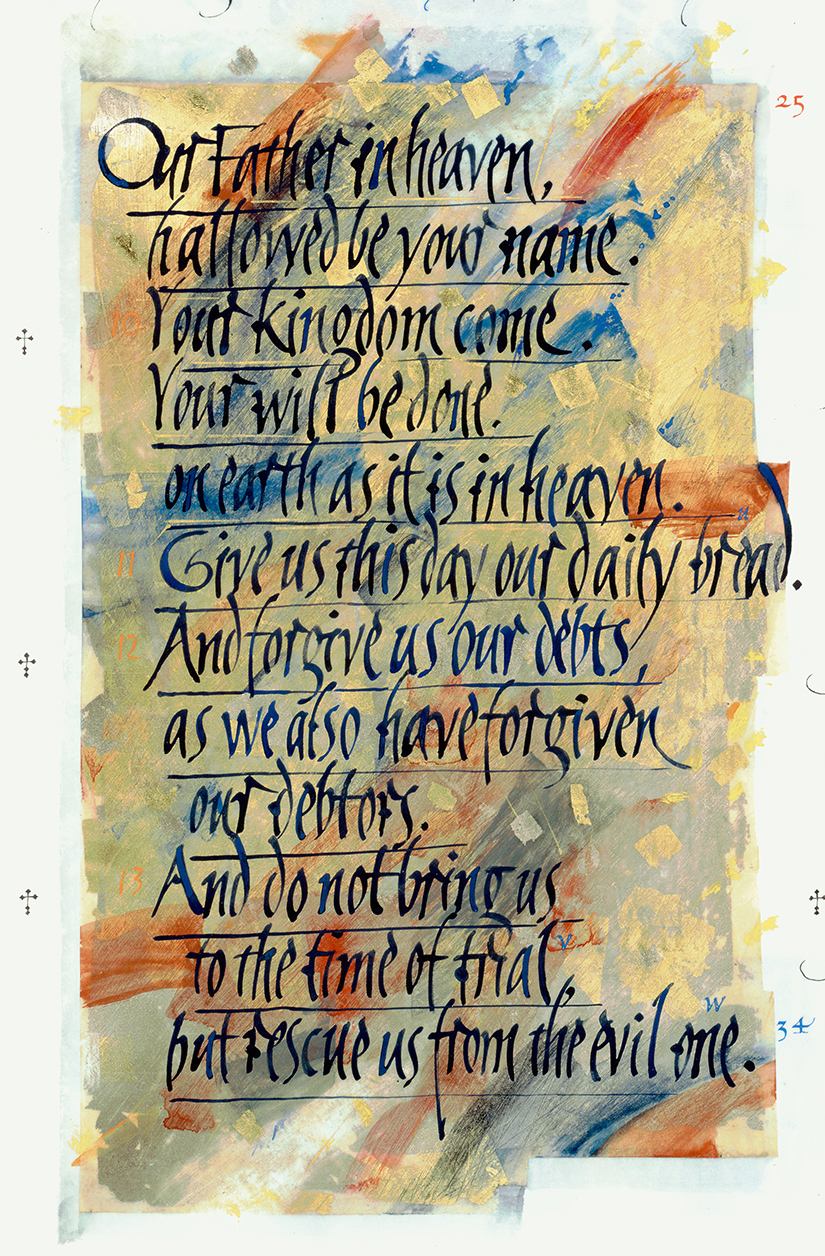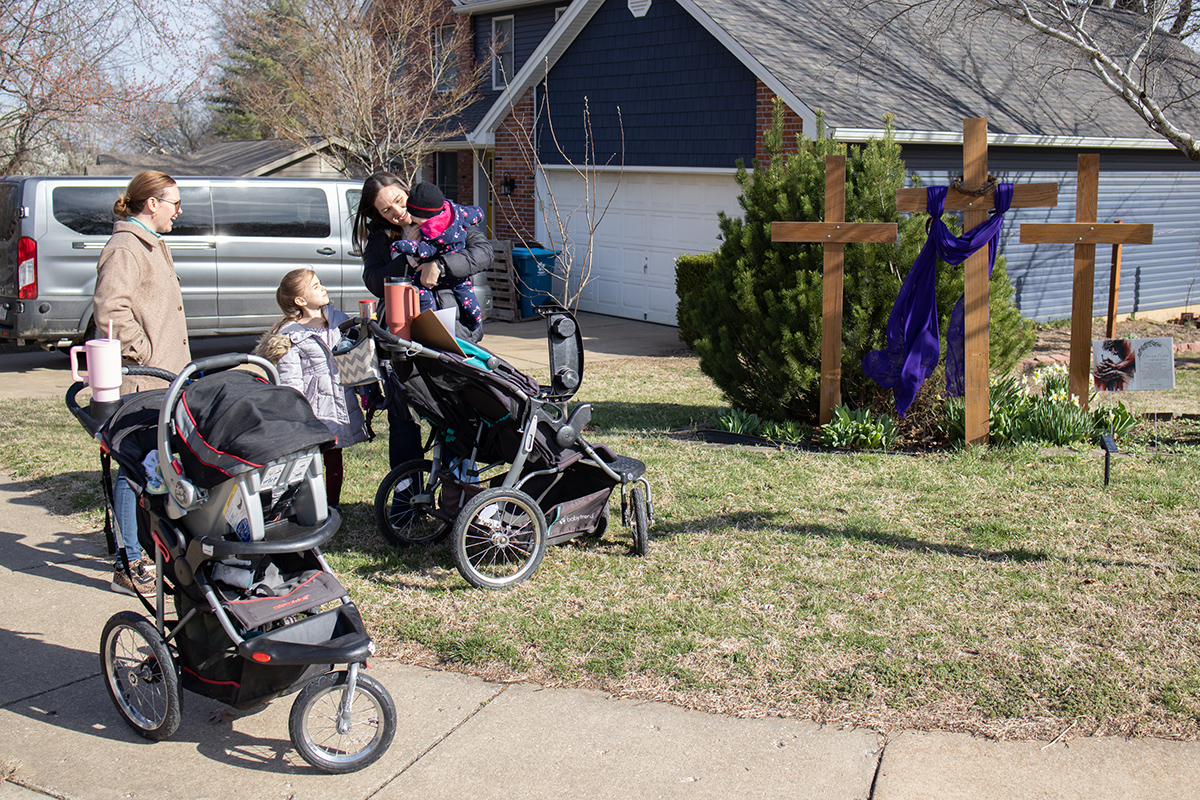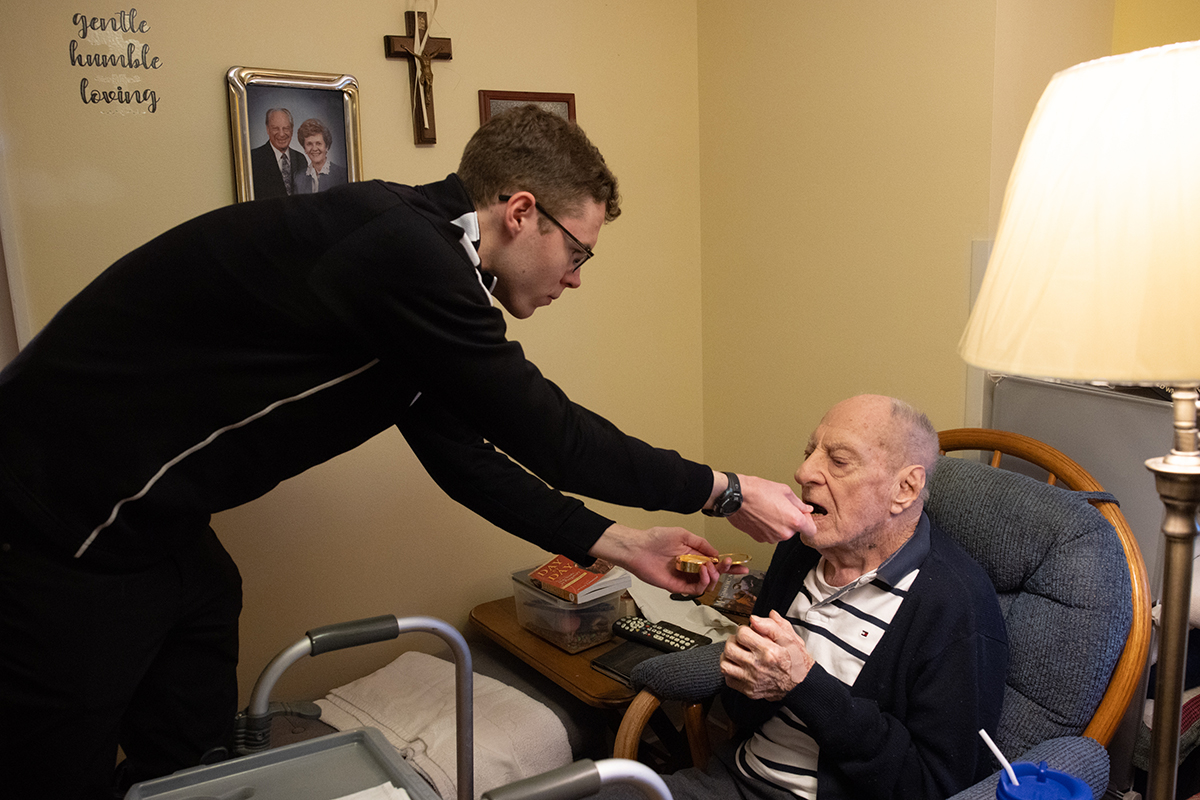Practices of lectio divina, visio divina allow us to more fully immerse ourselves into Scripture
Age-old practices of lectio divina and visio divina allow us to more deeply immerse ourselves into Scripture
Sacred Scripture has been studied for thousands of years. But what if we had the opportunity to more personally immerse ourselves into the Word of God?
Two practices of reading Scripture — lectio divina, meaning divine reading; and visio divina, or divine seeing — help us to contemplate the Scripture and apply it to our lives as we’re living at this moment.
Lectio Divina

A central element of Benedictine spiritual formation is the practice of lectio divina — the prayerful reading of Sacred Scripture with the “ears of the heart” and the eyes of faith. In this method of reading the Bible, the words on the page become God’s words to a person’s life at this very moment — words that provoke a response back to God.
Lectio divina takes a person beyond the words on the page. The four basic steps include lectio, meditatio, oratio and contemplatio — or read, meditate, pray and contemplate.
Benedictine Father Dominic Lenk said he would add another step to that: ruminatio, or to ruminate.
“That’s chewing on the words and asking, ‘What is that saying to me?’” said Father Lenk, of St. Louis Abbey in Creve Coeur and theology teacher at St. Louis Priory School. “You’re getting a sense of the flavor. So you slowly read the Scripture, and if a word hits you, you sit and rest with it.”
This way of prayer is one based on contemplation of the Scriptures through use of imagination, visualizing and entering into the scenes as God leads and inspires us.
The concept of scriptural reflection and interpretation go back to Origen of Alexandria, a third-century Christian scholar, ascetic and theologian. St. Ambrose also taught the practice to St. Augustine. The monastic practice was first established in the sixth century by St. Benedict and was then formalized as a four-step process by the Carthusian monk Guigo II during the 12th century.
In the 20th century, the constitution Dei verbum of the Second Vatican Council recommended lectio divina to the general public. Its importance was affirmed by Pope Benedict XVI: “As a strong point of biblical ministry, Lectio divina should therefore be increasingly encouraged, also through the use of new methods, carefully thought through and in step with the times. It should never be forgotten that the Word of God is a lamp for our feet and a light for our path.”
Lectio divina is not meant to be an academic exercise, Father Lenk said, where the reader spends much time trying to interpret the words of the Scripture writer.
“One of the pitfalls is you are reading along, and you think, ‘Gee, I wonder what this word was and why they used it?’ So you do a Bible search and get caught up in the academic side, and you miss the point of the prayer.”
For example, in the Gospel of Matthew, the disciples gathered on the mountain before Jesus’ Ascension. In Scripture, it’s said that some worshiped, but some doubted. (Matthew 28:16-20)
“We know how the story ends, but they didn’t,” Father Lenk said. “We look at it as, what does this mean, and where do I go from here? I don’t know how my life story is going to end, but how do I take this and let it ruminate? How do I grow in that trust of Jesus, that He will lead me where I need to be?”
Visio Divina

The practice of praying with visual images is called visio divina or divine seeing. It is adapted from lectio divina.
There are six steps: Listen and meditate on Scripture; see with eyes of faith as you look at the illuminations; pray to God, contemplate the Holy Spirit’s movements and reflect on how to become further Christ-like.
The Saint John’s Bible is an example of Scripture that employs the practice of visio divina. The hand-illuminated Bible, which was commissioned by Benedictine-sponsored Saint John’s University in Collegeville, Minnesota, gives the viewer a different experience in which Scripture is encouraged to be seen and read aloud.
The Saint John’s Bible reflects Benedictine values, including themes of hospitality, conversion of life and justice for God’s people. Examples contained in the illuminations include gold leaf, representing the divine; silver for wisdom; and rainbows to show God’s promise. The images use a large range of artistic styles, including iconography, abstraction, chrysography and illustration.
Father Lenk was a student at Saint John’s University in the late 1990s, just as the project was beginning. “Handwritten Bibles are in our tradition,” he said. “It was the monks who transcribed everything. The prayer books, the (Benedictine) Rule, everything was written out by the Benedictines. It hadn’t been done for 500 years, and here was the opportunity. Sure, there was prayer and discerning to seek God’s will.”
The Benedictine influence is evident in how the Word comes alive through the art found in the illuminations. In the famous Benedictine tradition of lectio divina, where the text is prayerfully read, the illuminated Bible is more of a visio divina, where the art tells the story.
“What’s nice about these images is that it’s not exactly representing what the picture is showing,” Father Lenk said. “We see it in the image of the nativity, and all the things that people can see in that one image. It really enriches and takes you deeper into the text.”
Icons are another example in the practice of visio divina, in that through prayer and contemplation of the image, much can be revealed to us. Father Lenk noted an example of an icon he owns of the Madonna and child, in which both are looking at one another. Many icons of the Blessed Mother and Jesus typically do not portray them looking at each other, he explained.
“It draws me into being with them and into their relationship,” Father Lenk said. “Am I worthy to be in that relationship, and how can I become part of that relationship?”
LECTIO DIVINA – IMAGINATIVE PRAYER

By Dawn Hausmann, Director of Consecrated Vocations for the Diocese of Lansing Faith Catholic
This way of prayer is one based on contemplation of the Scriptures through use of imagination, visualizing and entering into the scenes as God leads and inspires you.
For some people, using the imagination comes a little easier than for others, which makes this form of prayer more accessible. However, for those who are not as imaginative, I encourage you not to be discouraged but remain patient with yourself and with the process of learning how to pray this way. It takes time to get used to resting in the scene and waiting to be led by God through it.
Now for the practical steps:
• Take a few moments to rest in the Lord’s presence acknowledging that He is there with you, that He loves you and that He so desires to commune with you in this time and speak to your heart.
• Take a few deep breaths and invite the Lord to lead this prayer time for you.
• In the silence of your heart, give the Holy Spirit permission to inspire your imagination.
• Now, once you are peaceful and collected, open to a Scripture. The Gospel stories are the easiest ones to use for this prayer of contemplation.
• Read the passage one time through and just be still, “sitting with it” for a few minutes.
• Read the same passage again and pay attention to the details of the scene that come to the forefront of your mind; allow yourself to get lost in the scene.
• What is the atmosphere of the scene?
• What are the smells?
• Which of the characters captures your attention?
• What detail about that particular character or situation resonates with you?
• What emotions arise as you enter into the situation? Pay attention to those emotions and invite the Lord to show you how they pertain to your life situation.
• Are there any aspects of this scene that relate to what you are dealing with in life, work or in relationships right now?
• How are you relating to Jesus (or the Father) in this scene?
• Are there any specific details of the scene that you are focused on?
• Go back and read the passage again if you feel that it will be helpful.
• Take some time to dialogue with the Lord about what he is speaking to you and how it applies to your life. Take note of any actions or insights that the Lord may be speaking to you.
• Take a moment to journal about what God is speaking to you if you have the time.
• You may end this time of prayer with a Glory Be, Hail Mary or Our Father.
>> The Saint John’s Bible
Saint John’s University, a Benedictine university in Collegeville, Minnesota, commissioned Donald Jackson to oversee the creation of The Saint John’s Bible, a hand-written and illuminated Bible, in part to celebrate the new millennium.
Jackson is senior scribe to the Queen of England and a world-renowned artist and calligrapher. Referred to as “America’s Book of Kells” by Newsweek Magazine, the Bible is the first to be commissioned by a Benedictine monastery in over 500 years.
Inspired by handwritten, illuminated Bibles at the British Library in London, Jackson knew he wanted to create a similar work of art for the modern age. Working with a group of art historians, medievalists, artists, biblical scholars and theologians in Collegeville, Jackson and his team of calligraphers and artists created the 1,165-page manuscript, using the text and notes of the New Revised Standard Version translation. Each page of calligraphy took about eight to 12 hours to complete, and some of the 160 major illuminations took months. The project was completed in 15 years.
In 2013, Jackson completed the seventh and final volume of the Heritage Edition, a reproduction of all seven volumes. The edition is used in liturgies, by scholars, in presentations and in the everyday activities of faith communities.
A seven-volume Heritage Edition (a fine art reproduction of the original, handwritten Bible) was permanently installed at the Cathedral Basilica of St. Louis in 2017. The volumes include Pentateuch, Historical Books, Wisdom Books, Psalms, Prophets, Gospels and Acts, and Letters and Revelation.
Docent-led viewings of the Saint John’s Bible at the Cathedral Basilica of St. Louis are available upon request, contact Susie Irons at (314) 373-8205 or sirons@cathedralstl.org.
Seeing the Word is a program of guided reflection that makes it possible to pray with images from The Saint John’s Bible. For more information, see www.seeingtheword.org.
Sacred Scripture has been studied for thousands of years. But what if we had the opportunity to more personally immerse ourselves into the Word of God? Two practices of reading … Practices of lectio divina, visio divina allow us to more fully immerse ourselves into Scripture
Subscribe to Read All St. Louis Review Stories
All readers receive 5 stories to read free per month. After that, readers will need to be logged in.
If you are currently receive the St. Louis Review at your home or office, please send your name and address (and subscriber id if you know it) to subscriptions@stlouisreview.com to get your login information.
If you are not currently a subscriber to the St. Louis Review, please contact subscriptions@stlouisreview.com for information on how to subscribe.







